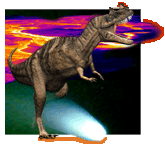Extended Cretaceous/Tertiary boundary extinctions and delayed population change in planktonic foraminifera from Brazos River, Texas
Type
High-resolution planktonic foraminiferal analysis of three Brazos River sections indicates a nearly continuous Cretaceous/Tertiary [K/T] boundary sedimentary record second only to the world's most complete record at El Kef, Tunisia. Species extinctions occur over an extended period of time and with two major extinction episodes. The first extinction episode with 46% of the species extinct occurs at and just below [10–15 cm] a short hiatus at the base of a sandy shell hash and clay-sand unit which was interpreted by Bourgeois et al. [1988] to represent a tsunami bed generated by the K/T boundary bolide impact. The top of this tsunami bed is about 17–20 cm below the K/T boundary as defined by the first appearance of Tertiary planktonic foraminifera. The second extinction phase with 45% of the species extinct occurs 25 cm above the K/T boundary [Zone P0/P1a boundary]. Of the remaining seven surviving Cretaceous species, six gradually disappear during planktonic foraminiferal Subzones P1a and basal P1b. No species extinctions or major faunal assemblage changes are directly associated with the K/T boundary. Iridium distribution is ambiguous, with one peak in the upper part of the tsunami bed and a second peak at the micropaleontologically defined K/T boundary. Relative abundances of dominant species are stable through the Late Maastrichtian, and only minor abundance changes coincide with the first extinction episode or the K/T boundary. The first major faunal change in the dominant species group coincides with the second extinction episode and leads to decline and eventual extinction of this group in Subzone P1a. Species disappearing at the two extinction episodes [46% and 45%] constitute only a small percentage [8% and 5%] of the individuals of the total planktonic foraminiferal population. This suggests that weakened species with low numbers of individuals and sensitive to relatively minor environmental changes were primarily affected by these extinction episodes. Magnetostratigraphy indicates that the first extinction phase began about 310,000 years before the K/T boundary, and the second extinction phase occurred 50,000 years after the K/T boundary. This stepped pattern of species extinctions suggests a progressively stressed ecosystem in continental shelf settings which may be related to an observed sea level regression and global cooling. The hypothesis of a global catastrophic mass extinction at the K/T boundary caused by a large extraterrestrial impact is not supported by the Brazos River planktonic foraminiferal data. PDF

